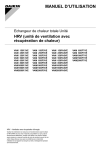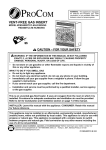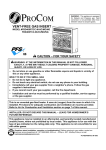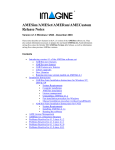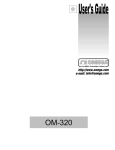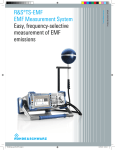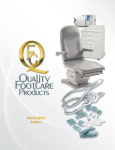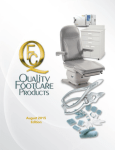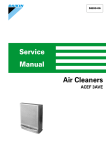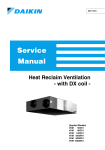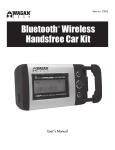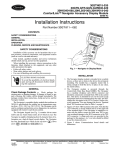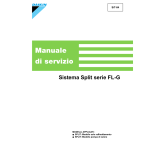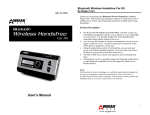Download Service Manual Heat Recovery Ventilation
Transcript
SiE00-01 Service Manual Heat Recovery Ventilation [Applied Models] VAM 150FJVE VAM 250FJVE VAM 350FJVE VAM 500FJVE VAM 650FJVE VAM 800FJVE VAM1000FJVE VAM1500FJVE VAM2000FJVE SiE00-01 Heat Recovery Ventilation VAM 150FJVE VAM 250FJVE VAM 350FJVE VAM 500FJVE VAM 650FJVE VAM 800FJVE VAM1000FJVE VAM1500FJVE VAM2000FJVE Table of Contents i SiE00-01 1. Introduction .............................................................................................v 1.1 Safety Cautions ....................................................................................... v Part 1 General Constructions .......................................................1 1. General Constructions ............................................................................2 1.1 Explanation.............................................................................................. 2 Part 2 Product Specification ........................................................5 1. Product Specification ..............................................................................6 1.1 Specification ............................................................................................ 6 Part 3 Operation ............................................................................9 1. Operation ..............................................................................................10 1.1 Explanation for Systems........................................................................ 10 1.2 Operation with The Remote Control for Air Conditioning Operation HRV Units. (BRC301B61) ..................... 11 Part 4 Maintenance .....................................................................15 1. Maintenance..........................................................................................16 1.1 Maintenance for The Air Filter ............................................................... 16 1.2 Maintenance for The Heat Exchange Element...................................... 19 Part 5 Control Functions .............................................................21 1. Control Functions ..................................................................................22 1.1 List of Control Functions........................................................................ 22 1.2 Explanation of Individual Functions ....................................................... 23 1.3 Layout of switches on Printed Circuit Board.......................................... 28 Part 6 Circuit Operations ............................................................29 1. Circuit Operations .................................................................................30 1.1 Circuit Configuration .............................................................................. 30 1.2 Circuit Functions.................................................................................... 31 Part 7 Troubleshooting ...............................................................33 1. Troubleshooting ....................................................................................34 1.1 1.2 1.3 1.4 1.5 1.6 1.7 1.8 1.9 Error Code Indication............................................................................. 34 Overall Alarm......................................................................................... 35 Overall Malfunction................................................................................ 36 Indoor Air Thermistor Error.................................................................... 37 Outdoor Air Thermistor Error ................................................................. 38 Damper System Error (Alarm) ............................................................... 39 Damper System Error (Alarm) ............................................................... 40 Dedicated LCD Remote Controller ........................................................ 41 Data Transmission Error (Between LCD Remote Controller and Main Unit)................................. 42 1.10 Data Transmission Error (LCD Remote Controller)............................... 43 ii Table of Contents SiE00-01 1.11 Data Transmission Error (Between LCD Master Remote Controller and Slave Remote Controller) ............................................................... 44 1.12 Field Setting Error.................................................................................. 45 1.13 Overlapping Central Control Address.................................................... 46 1.14 Main Unit PCB Assembly ...................................................................... 47 1.15 Dedicated LCD Remote Controller ........................................................ 48 1.16 How to Check ........................................................................................ 49 1.17 Thermistor ............................................................................................. 50 1.18 Power Transformer................................................................................ 51 1.19 Damper Motor........................................................................................ 52 Part 8 Supplementary Explanation .............................................53 1. Supplementary Explanation ..................................................................54 1.1 Field Setting, Service Mode Operation.................................................. 54 Part 9 Appendix...........................................................................65 1. Appendix ...............................................................................................66 1.1 Wiring Diagram...................................................................................... 66 Index .............................................................................................i Drawings & Flow Charts ................................................................ v Table of Contents iii SiE00-01 iv Table of Contents SiE00-01 Introduction 1. Introduction 1.1 Safety Cautions Cautions and Warnings Be sure to read the following safety cautions before conducting repair work. The caution items are classified into “ Warning” and “ Caution”. The “ Warning” items are especially important since they can lead to death or serious injury if they are not followed closely. The “ Caution” items can also lead to serious accidents under some conditions if they are not followed. Therefore, be sure to observe all the safety caution items described below. About the pictograms This symbol indicates an item for which caution must be exercised. The pictogram shows the item to which attention must be paid. This symbol indicates a prohibited action. The prohibited item or action is shown inside or near the symbol. This symbol indicates an action that must be taken, or an instruction. The instruction is shown inside or near the symbol. After the repair work is complete, be sure to conduct a test operation to ensure that the equipment operates normally, and explain the cautions for operating the product to the customer v Introduction 1.1.1 vi Cautions in Operation and Maintenance SiE00-01 SiE00-01 Introduction vii Introduction 1.1.2 SiE00-01 Using Icons Icons are used to attract the attention of the reader to specific information. The meaning of each icon is described in the table below: 1.1.3 Using Icons List Icon Type of Information Description Note A “note” provides information that is not indispensable, but may nevertheless be valuable to the reader, such as tips and tricks. Caution A “caution” is used when there is danger that the reader, through incorrect manipulation, may damage equipment, loose data, get an unexpected result or has to restart (part of) a procedure. Warning A “warning” is used when there is danger of personal injury. Reference A “reference” guides the reader to other places in this binder or in this manual, where he/she will find additional information on a specific topic. Note: Caution Warning viii SiE00-01 Part 1 General Constructions 1. General Constructions ............................................................................2 1.1 Explanation.............................................................................................. 2 General Constructions 1 General Constructions SiE00-01 1. General Constructions 1.1 Explanation VAM150FJVE VAM250FJVE VAM350FJVE VAM500FJVE VAM650FJVE VAM800FJVE VAM1000FJVE 2 1 Ceiling Hock 2 Duct Connection Flange 3 Exhaust Fan 4 Air Filter (Long Life Filter) 5 Damper 6 Switch Box 7 Maintenance Cover 8 Heat Exchange Elements 9 Name Plate 10 Air Supply Fan 11 Remote Controller (Option Parts) 12 Damper Motor 13 EA (Exhaust Air) [Exhaust Air to Outdoor] 14 OA (Outdoor Air) [Fresh Air from Outdoor] 15 Maintenance Space for The Air Filters, Heat Exchange Elements and Switch Box 16 RA (Return Air) [Exhaust Air from Room] 17 SA (Supply Air) [Feed Air to Room] General Constructions SiE00-01 General Constructions VAM1500FJVE VAM2000FJVE General Constructions 1 Ceiling Hock 2 Duct Connection Flange 3 Exhaust Fan 4 Air Filter (Long Life Filter) 5 Damper 6 Switch Box 7 Maintenance Cover 8 Heat Exchange Elements 9 Name Plate 10 Air Supply Fan 11 Remote Controller (Option Parts) 12 Damper Motor 13 EA (Exhaust Air) [Exhaust Air to Outdoor] 14 OA (Outdoor Air) [Fresh Air from Outdoor] 15 Maintenance Space for The Air Filters, Heat Exchange Elements and Switch Box 16 RA (Return Air) [Exhaust Air from Room] 17 SA (Supply Air) [Feed Air to Room] 3 General Constructions 4 SiE00-01 General Constructions SiE00-01 Part 2 Product Specification 1. Product Specification ..............................................................................6 1.1 Specification ............................................................................................ 6 Product Specification 5 Product Specification SiE00-01 1. Product Specification 1.1 Specification (50 / 60Hz) Model Name Power Supply Temperature Exchanging Efficiency Enthalpy Exchange Efficiency Cooling Heating Casing Insulating Material Dimensions Heat Exchanging System Heat Exchanging Element Air Filter Fan Type Fan Speed External Static Pressure Fan Motor Motor Output Operating Sound Heat Exchange Mode Byapss Mode Operation Range (Ambient) Connection Duct Diameter Weight Drawing Number VAM150FJVE Ultra-High High Low Ultra-High High Low Ultra-High High Low % % % % % % % % % HxWxD mm Ultra-High High Low Ultra-High High Low m³ / h m³ / h m³ / h Pa Pa Pa Type kW dBA dBA dBA dBA dBA dBA Ultra-High High Low Ultra-High High Low mm kg VAM250FJVE VAM350FJVE Single Phase 220 – 240 V / 220 V, 50 / 60 Hz 74 / 74 72 / 72 75 / 75 74 / 74 72 / 72 75 / 75 79 / 80 77 / 77 80 / 81 58 / 58 58 / 58 61 / 61 58 / 58 58 / 58 61 / 61 64 / 66 62 / 63 67 / 68 64 / 64 64 / 64 65 / 65 64 / 64 64 / 64 65 / 65 69 / 71 68 / 69 70 / 71 Galvanized Steel Plate Self-extinguishable Urethane Foam 269 x 760 x 509 269 x 760 x 509 285 x 812 x 800 Air to Air Cross Flow Total Heat (Sensible Heat + Latent Heat) Exchange Specially Processed Nonflammable Paper Multidirectional Fibrous Fleeces Sirroco Fan 150 / 150 250 / 250 350 / 350 150 / 150 250 / 250 350 / 350 110 / 110 155 / 145 230 / 210 69 / 98 64 / 98 98 / 142 39 / 54 39 / 54 70 / 85 20 / 24 20 / 20 25 / 15 Open Type Capacitor Permanent Split-phase Induction Motor, 4 Poles x 2 0.030 x 2 0.030 x 2 0.090 x 2 27 – 28.5 / 28.52 28 – 29 / 29.5 32 – 34 / 34.5 26 – 27.5 / 26.5 26 – 27 / 26 31.5 – 33 / 32 20.5 – 21.5 / 19 21 – 22 / 19.5 23.5 – 26 / 22 27 – 28.5 / 28 28 – 29 / 29 32 – 34 / 34.5 26.5 – 27.5 / 27 27 – 28 / 27 31 – 32.5 / 33 20.5 – 21.5 / 20 21 – 22 / 20.5 24.5 – 26.5 / 22 – 10°C to 50°CDB (80% RH or Less) φ 100 φ 150 φ 150 24 24 33 4D020371A 4D020372A 4D020373A Test conditions are as follows Condition Notes: 6 Indoor unit Outdoor unit °CDB R.H (%) °CDB R.H (%) Cooling condition 27 50 35 60 Heating condition 20 40 7 70 1. Operation sound is measured at 1.5 m below the center the body. 2. Fan speed can be changed over to Low mode or High mode. 3. Operating sound is measured in an anechoic chamber. Operating sound level generally become greater than this value depending on the operating conditions, reflected sound, and peripheral noise. 4. The sound level at the air discharge port is about 8 dB higher than the unit’s operating sound. Product Specification SiE00-01 Product Specification (50 / 60Hz) Model Name Power Supply Temperature Exchanging Efficiency Enthalpy Exchange Efficiency Cooling Heating Casing Insulating Material Dimensions Heat Exchanging System Heat Exchanging Element Air Filter Fan Type Fan Speed External Static Pressure Fan Motor Motor Output Operating Sound Heat Exchange Mode Byapss Mode Operation Range (Ambient) Connection Duct Diameter Weight Drawing Number VAM500FJVE Ultra-High High Low Ultra-High High Low Ultra-High High Low % % % % % % % % % HxWxD mm Ultra-High High Low Ultra-High High Low m³ / h m³ / h m³ / h Pa Pa Pa Type kW dBA dBA dBA dBA dBA dBA Ultra-High High Low Ultra-High High Low mm kg VAM650FJVE VAM800FJVE Single Phase 220 – 240 V / 220 V, 50 / 60 Hz 74 / 74 74 / 74 74 / 74 74 / 74 74 / 74 74 / 74 77 / 78.5 77 / 78 76 / 76 58 / 58 58 / 58 60 / 60 58 / 58 58 / 58 60 / 60 63 / 65.5 63 / 65 62 / 63 62 / 62 63 / 63 65 / 65 62 / 62 63 / 63 65 / 65 67 / 68.5 66 / 68 67 / 68 Galvanized Steel Plate Self-extinguishable Urethane Foam 285 x 812 x 800 348 x 988 x 852 348 x 988 x 852 Air to Air Cross Flow Total Heat (Sensible Heat + Latent Heat) Exchange Specially Processed Nonflammable Paper Multidirectional Fibrous Fleeces Sirroco Fan 500 / 500 650 / 650 800 / 800 500 / 500 650 / 650 800 / 800 350 / 300 500 / 440 670 / 660 98 / 147 93 / 162 137 / 225 54 / 54 39 / 69 98 / 118 25 / 20 25 / 34 49 / 69 Open Type Capacitor Permanent Split-phase Induction Motor, 4 Poles x 2 0.140 ∞ 2 0.230 ∞ 2 0.090 ∞ 2 33 – 34.5 / 34 34.5 – 35.5 / 36 36 – 37 / 37 31.5 – 33 / 31 33 – 34 / 33 34.5 – 36 / 35 24.5 – 26.5 / 24 27 – 28 / 27 31 – 32 / 30 33.5 – 34.5 / 35 34.5 – 35.5 / 35.5 36 – 37 / 37 32.5 – 33.5 / 33 34 – 35 / 34 34.5 – 36 / 35 25.5 – 27.5 / 24 27 – 28.5 / 27 31 – 33 / 31 – 10°C to 50°CDB (80% RH or Less) φ 200 φ 200 φ 250 33 48 48 4D020374A 4D020375A 4D020376A Test conditions are as follows Condition Notes: Product Specification Indoor Outdoor °CDB R.H (%) °CDB R.H (%) Cooling condition 27 50 35 60 Heating condition 20 40 7 70 1. Operation sound is measured at 1.5 m below the center the body. 2. Fan speed can be changed over to Low mode or High mode. 3. Operating sound is measured in an anechoic chamber. Operating sound level generally become greater than this value depending on the operating conditions, reflected sound, and peripheral noise. 4. The sound level at the air discharge port is about 8 dB higher than the unit’s operating sound. 7 Product Specification SiE00-01 (50 / 60Hz) Model Name Power Supply Temperature Exchanging Efficiency Enthalpy Exchange Efficiency Cooling Heating Casing Insulating Material Dimensions Heat Exchanging System Heat Exchanging Element Air Filter Fan Type Fan Speed External Static Pressure Fan Motor Motor Output Operating Sound Heat Exchange Mode Byapss Mode Operation Range (Ambient) Connection Duct Diameter Weight Drawing Number VAM1000FJVE Ultra-High High Low Ultra-High High Low Ultra-High High Low % % % % % % % % % H∞W∞D mm Ultra-High High Low Ultra-High High Low m∏ / h m∏ / h m∏ / h Pa Pa Pa Type kW dBA dBA dBA dBA dBA dBA Ultra-High High Low Ultra-High High Low mm kg VAM1500FJVE VAM2000FJVE Single Phase 220 – 240 V / 220 V, 50 / 60 Hz 75 / 75 75 / 75 75 / 75 75 / 75 75 / 75 75 / 75 76.5 / 78 78 / 78 78 / 78 61 / 61 61 / 61 61 / 61 61 / 61 61 / 61 61 / 61 63 / 66 64 / 64 66 / 66 66 / 66 66 / 66 66 / 66 66 / 66 66 / 66 66 / 66 68 / 71 68 / 68 70 / 70 Galvanized Steel Plate Self-extinguishable Urethane Foam 348 x 988 x 1140 710 x 1498 x 852 710 x 1498 x 1140 Air to Air Cross Flow Total Heat (Sensible Heat + Latent Heat) Exchange Specially Processed Nonflammable Paper Multidirectional Fibrous Fleeces Sirroco Fan 1000 / 1000 1500 / 1500 2000 / 2000 1000 / 1000 1500 / 1500 2000 / 2000 870 / 800 1200 / 1200 1400 / 1400 157 / 196 137 / 206 137 / 196 98 / 108 98 / 118 78 / 88 78 / 69 49 / 69 59 / 69 Open Type Capacitor Permanent Split-phase Induction Motor, 4 Poles ∞ 2 0.230 ∞ 4 0.230 ∞ 4 0.230 ∞ 2 36 – 37 / 37 39.5 – 41.5 / 40.5 40 – 42.5 / 41 35 – 36 / 35 38 – 39 / 38 38 – 41 / 38 31 – 32 / 30 34 – 36 / 33 35 – 37 / 35 36 – 37 / 37 40.5 – 41.5 / 40.5 40 – 42.5 / 41 35.5 – 36 / 35 38 – 39 / 38 38 – 41 / 38 31 – 32 / 31 33.5 – 36 / 33 35 – 37 / 35 – 10°C to 50°CDB (80% RH or Less) φ 250 φ 350 φ 350 61 132 158 4D020377A 4D020526A 4D020527A Test conditions are as follows Condition Notes: 8 Indoor unit Outdoor unit °CDB R.H (%) °CDB R.H (%) Cooling condition 27 50 35 60 Heating condition 20 40 7 70 1. Operation sound is measured at 1.5 m below the center the body. 2. Fan speed can be changed over to Low mode or High mode. 3. Operating sound is measured in an anechoic chamber. Operating sound level generally become greater than this value depending on the operating conditions, reflected sound, and peripheral noise. 4. The sound level at the air discharge port is about 8 dB higher than the unit’s operating sound. Product Specification SiE00-01 Part 3 Operation 1. Operation ..............................................................................................10 1.1 Explanation for Systems........................................................................ 10 1.2 Operation with The Remote Control for Air Conditioning Operation HRV Units. (BRC301B61) .......................... 11 Operation 9 Operation SiE00-01 1. Operation 1.1 Explanation for Systems This product is operated differently depending on the system configuration. For the operation of the remote controller for indoor unit and centralized controller, refer to the instruction manual provided with each unit. Operation for Each System System Example Operation Method Independent System The remote controller turns on and off the air conditioner and HRV unit. Combined Operation System with VRV Systems and Skyair Series The remote controller for VRV turns on and off the air conditioner and HRV unit. If only the HRV unit is used without operating the air conditioner, set the unit in the “ “ VENTILATION mode. The ON/OFF and timer operation can not be performed using the HRV remote controllers. (The indication of centralized control “ “ appears on the display.) Other operations can be performed using the HRV remote controllers. Starting and stopping operations of the indoor unit and the HRV unit can be performed using the indoor remote controllers. Centralized System When the HRV remote controllers is not connected, the Centralized controller controls the operation of the HRV unit. When the HRV remote controllers is connected, operation can be started and stopped using the Centralized controller or the indoor and the HRV remote controllers. During the indication of centralized control “ “ appears on the display, the ON/ OFF and timer operation may not be possible with the HRV remote controlers. Other operations can be performed using the HRV remote controllers. 10 Operation SiE00-01 1.2 Operation Operation with The Remote Control for Air Conditioning Operation HRV Units. (BRC301B61) For non-independent systems, starting/stopping operation and timer operation may not be possible. Use the air conditioner remote control or the Centralized controller in such cases. Operation for INDIVIDUAL SYSTEM 1. Operation lamp This pilot lamp (red) light up while the unit is in Operation. 2. Operation/Stop button When pushed once, the unit starts operating. When pushed twice, the unit stops. 3. Air flow rate changeover button Air flow rate can be changed over to “ “ [Low] mode or “ “ [High] mode, “ [Low FRESH UP] mode, “ FRESH UP“ [High FRESH UP] mode. Remote Controller for HRV BRC301B61 5 7 1 FRESH UP“ 2 6 8 11 12 13 4 10 9 3 (HL006) For “Freshup“ operation When this indication does not show: The volume of outdoor air supplied into the room and that of the room air exhausted outdoors is equivalent. For “Freshup“ operation, If it is set to “Fresh up air supply“: The volume of outdoor air supplied into the room is larger than that of room air exhausted outdoors. (This operation prevents the odor and moisture from kitchens and toilets from flowing into the rooms. If it is set to “Fresh up air exhaust“: The volume of room air exhausted outdoors is larger than that of outdoor air suppied into the room. (This operation prevents the hospital odor and floating bacteria from flowing out to the corridors.) Operation 11 Operation SiE00-01 4. Ventilation mode changeover: button “ “ (Automatic) mode ...... The temperature sensor of the unit automatically changes the ventilation of the unit in [Bypass] mode and [Heat Exchange] mode. “ “ (Heat Exchange) mode ...... In this mode, the air passes through the heat exchange element to effect [Total Heat Exchanging] ventilation. “ “ (Bypass) mode ...... In this mode, the air does not pass through the heat exchange element but bypasses it to effect [Bypass] ventilation. 5. Indication of operation control method: When the operation of HRVs are linked with the air conditioners, this indication may be shown. While the indication is shown, the ON/OFF of HRVs cannot be operated by the HRV remote controller. 6. Indication of operation standby: It indicates the precooling/preheating operation. This unit is at stop and will start operation after the precooling/preheating operation is over. Precooling/preheating operation means the operation of HRVs is delayed during the startup operation of linked air conditioners such as before the office hours. During this period the cooling or heating load is reduced to bring the room temperature to the set temperature in a short time. 7. Indication of centralized control: When a remote controller for air conditioners or devices for centralized control are connected to the HRVs, this indication may show. During this indication appears on the display, the ON/OFF and timer operation may not be possible with the HRV remote controllers. 8. Indication of air filter cleaning When the indication “ “ appears on the display, clean the filter. 9. Filter signal reset button 10. Inspection button This button is to be used only for service. It is not to be used normally. HOW TO OPERATE WITH TIMER 11. Push the button “ “ and select either one of “ “ or “ Each time the button is pushed, the indication changes as shown below. “. 12. Push the button “ “ and set the time. Each time when “ “ is pushed, the time advances one hour. Each time when “ “ is pushed, the time goes back one hour. 13. Push the button “ “. Then, the reservation is finished. Either “ “ or “ “ changes from flashing to lighting. After the reservation is finished, the remaining time is indicated in the display. For cancelling the timer operation, push the button “ “ once again. The indication disappears. 12 Operation SiE00-01 Operating The HRV Unit Using The Remote Controller of The VRV. System Air Conditioner Operation When the VRV-system air conditioner is connected with the HRV unit with a direct duct, the remote controller of the air conditioner cannot be used to select the VENTILATION mode. To use the HRV unit without operating the air conditioner, set the air conditioner in the FAN VENTILATION mode and select the low fan speed. 1. Operation lamp 2. Operation/stop button 3. Operation mode display 4. Operation mode selector Remote Controller for VRV BRC1A61·62 Every time the operation mode selector is pressed, the operation mode display changes as shown below. (example) When air conditioner and HRV unit are not connected by duct When the Independent Operation of The HRV Unit Using The Centralized Controller (DCS302B61) Operation When air conditioner and HRV unit are connected by duct “FILTER“ indication appears on the display, clean the filter of the HRV unit. After selecting the zone where the only the HRV unit operation is desired, press the operation mode selector and select “ “ VENTILATION. The HRV unit can then be operated independently from the air conditioner. When the “FILTER“ indication apprears on the display, clean the filter of the HRV unit. 13 Operation SiE00-01 14 Operation SiE00-01 Part 4 Maintenance 1. Maintenance..........................................................................................16 1.1 Maintenance for The Air Filter ............................................................... 16 1.2 Maintenance for The Heat Exchange Element...................................... 19 Maintenance 15 Maintenance SiE00-01 1. Maintenance 1.1 Maintenance for The Air Filter Caution During operation, never check or clean the HRV. It may cause electrical shock and it is very dangerous to touch the rotating part. Be sure to turn off the OPERATION switch and disconnect the power. CLEANING FREQUENCY AT LEAST ONCE EVERY TWO YEARS (FOR GENERAL OFFICE USE) (CLEAN THE ELEMENT MORE FREQUENTLY IF NECESSARY.) 1. Go into ceiling through the inspection hole, remove the hanging metals of maintenance cover and take it off. VAM150~1000FJVE 1 Maintenance Cover 3 Hanging Metal 1 Maintenance Cover 3 Hanging Metal 2 Binding Metal 2 Binding Metal VAM1500~2000FJVE 16 Maintenance SiE00-01 Maintenance 2. Take out the heat exchange elements from the unit body. VAM150~1000FJVE 1 Heat Exchange Element (X2) 2 Handle 3 Rail 4 Filter x 2 1 Heat Exchange Element (X4) 2 Handle 3 Rail 4 Filter x 4 VAM1500~2000FJVE 3. To clean the air filter, lightly pat it with hand or remove dust with a vacuum cleaner. If excessively dirty, wash it in water. 4. If the air filter is washed, remove water completely and allow to dry Air filter for 20 to 30 minutes in the shade. When dried completely, install the air filter back in place. Maintenance 17 Maintenance SiE00-01 5. Install the maintenance cover securely in place. Caution 18 1. 2. 3. 4. 5. Do not wash the air filter in hot water. Do not dry the air filter over a fire. Do not expose the air filter to direct sunlight. Do not use organic solvent such as gasoline and thinner on the air filter. Be sure to install the air filter after servicing. (Missing air filter causes clogged heat exchange element.) The air filter is an optional item and the replacement is available. Maintenance SiE00-01 1.2 Maintenance Maintenance for The Heat Exchange Element CLEANING FREQUENCY AT LEAST ONCE EVERY TWO YEARS (FOR GENERAL OFFICE USE) (CLEAN THE ELEMENT MORE FREQUENTLY IF NECESSARY.) 1. Use a vacuum cleaner to remove dust and foreign objects on the surface of the heat exchange element. Use the vacuum cleaner equipped with a brush on the tip of the suction nozzle. Lightly contact the brush on the surface of the heat exchanging element when cleaning. (Do not crush the heat exchange element while cleaning.) 2. Install the air filter securely in place. 3. Put the heat exchange element on the rail and insert it securely in place. 4. Install the maintenance cover securely in place. Caution Maintenance Never wash the heat exchanger element with water. 19 Maintenance 20 SiE00-01 Maintenance SiE00-01 Part 5 Control Functions 1. Control Functions ..................................................................................22 1.1 List of Control Functions........................................................................ 22 1.2 Explanation of Individual Functions ....................................................... 23 1.3 Layout of switches on Printed Circuit Board.......................................... 28 Control Functions 21 Control Functions SiE00-01 1. Control Functions 1.1 List of Control Functions Classification 1. Basic functions (functions related to basic performance) Function name Outline of function 1.1 Ventilation operation control function Controls supply air fan motor, exhaust air fan motor and damper motor. 1.2 Abnormality control function Detects abnormalities in thermistor, damper motor and data transmission to prevent errors. 2. Additional functions 2.1 Ventilation mode changeover function Operates equipment in selected ventilation mode (total heat exchange, normal, automatic). 2.2 Automatic ventilation operation function Selects the most suitable ventilation mode by controlling damper motor according to temperature controller mode, temperature setting and thermistor data. 2.3 Ventilation capacity changeover function Operates equipment at set airflow rate. 2.4 Humidifier operation control function Controls humidifier output based on temperature controller judgment. Note 1 2.5 Pre-cool/pre-heat function Prevents equipment operation for a preset time (set time) after air conditioner is turned on. 2.6 Freshup function Sets motor tap so that supply air fan airflow rate is larger than exhaust air fan airflow rate. 2.7 Filter sign function Stores cumulative operation hour data and turns on air filter cleaning indicator. 3. System control functions 3.1 Remote controller Operates equipment according to instructions from remote function controller. 3.2 Group function Operates two or more units based on instructions from single remote controller. 3.3 Air conditioner link Follows air conditioner ON/OFF instructions. function 4. Other support functions Note: 22 3.4 Power ON operation function Operates equipment when power is turned on. 3.5 External link operation function Turns equipment on and off according to external link terminal signal (no-voltage contact a). 3.6 Centralized control function Allows remote control operation by centralized control equipment. 3.7 Timer function Turns equipment on and off at set time. 4.1 Troubleshooting function Displays error codes to indicate locations of error. 4.2 Field setting function Allows initial setting from LCD remote controller. Note 1 Requires optional humidifier and optional printed circuit board (KRP50-2 : Wiring adapter for remote contact). Control Functions SiE00-01 Control Functions 1.2 Explanation of Individual Functions 1.2.1 Ventilation Operation Control Controls ventilation fan motors (supply and exhaust air fans) and damper motor. 1) Normal operation Operation chart Remote controller indication Heat recovey ventilation unit Cleaning Operation time Ventilation fan motor Damper motor (ventilation mode) Operation lamp Filter sign reset Stop Normal ventilation mode selection ON Total heat exchange ventilation Total heat exchange ventilation ON Normal ventilation ON ON Filter sign indicator (HL020) 2) Direct duct connection with air conditioner Operation chart Air conditioner Operation ON/OFF Operation Fan motor ON Normal ventilation mode selection Air conditioner fan OFF Air conditioner fan ON Remote controller indication Heat recovery ventilation unit OFF Ventilation fan motor Damper motor (ventilation mode) 10 sec ON Total heat exchange ventilation ON Normal ventilation Total heat exchange ventilation ON Normal ventilation Operation lamp Lamp ON (HL021) Note: Control Functions Direct duct connection setting can be made in VRV system or using field setting mode of HRV LCD remote controller. 23 Control Functions 1.2.2 SiE00-01 Pre-cool/Pre-heat Pre-cool/pre-heat operations require the following conditions. 1. System Pre-heat operation is possible only in air conditioner linked system (1 group, 2-group link). Check the system first. 2. Heat recovery ventilation setting Set Preheat ON/OFF to ON. Pre-cool/pre-heat On/OFF setting can be made in air conditioner or using field setting mode of LCD remote controller of heat recovery ventilation unit. (Pre-cool time can be set between 30 and 60 min, and pre-heat time can be set between 30 and 150 min.) 3. Others a) Heat recovery ventilation unit must be in non-operating condition for two consecutive hours or more prior to pre-cool/pre-heat operation. b) Temperature control mode of the air conditioner must be set to Cool, Heat or Dry. Heat recovery ventilation unit Air conditioner Operation Normal ventilation Pre-cool/pre-heat mode selection time over ON/OFF Operation ON Ventilation fan motor Pre-cool/pre-heat ventilation Damper motor (ventilation mode) Total heat exchange ventilation Remote controller indication Stop Operation lamp Lamp ON Operation standby indication Lamp ON ON Normal ventilation Total heat exchange ventilation (HL022) Note: 24 Operation standby indication is displayed only on LCD remote controller of heat recovery ventilation unit. Control Functions SiE00-01 1.2.3 Control Functions Cold Area Mode Stops or lowers ventilation airflow during defrosting operation and compressor non-operating condition when equipment in heating mode, thus reducing heating load and cold air draft. Operation chart (in heating operation only) Air conditioner Operation ON/OFF Operation Fan motor ON Normal ventilation mode selection Defrosting operation or compressor in Non-defrosting operation or non-operation compressor in operation Remote controller indication Heat recovery ventilation unit OFF Ventilation fan motor 10 sec ON OFF or lower Damper motor (ventilation mode) Total heat exchange ventilation ON Normal ventilation Total heat exchange ventilation ON Normal ventilation Operation lamp Lamp ON (HL023) Note: 1.2.4 Cold area mode can set using remote controller for air conditioner or field setting mode of LCD remoter controller of heat recovery ventilation unit. Air Conditioner Link Operation Link system enables simultaneous ON/OFF operation of heat recovery ventilation unit and air conditioner (VRV system, Skyair). 1) 1 group link control Allows simultaneous ON/OFF from remote controller for air conditioner. Allows independent operation of heat recovery ventilation unit from VRV-system remote controller during interim periods (not possible when direct duct connection is used). ON/OFF operation is not possible from LCD remote controller of heat recovery ventilation unit. VRV system Remote LCD remote controller controller for for heat recovery air conditioner ventilation unit Control Functions (HL024) 25 Control Functions SiE00-01 2) Link control of 2 or more groups (zone link) Heat recovery ventilation unit can be operated when one or more air conditioners are operating. Allows independent operation of heat recovery ventilation unit from VRV-system remote controller during interim periods (direct duct connection is not allowed in this system). ON/OFF operation is not possible from LCD remote controller of heat recovery ventilation unit. Group 1 Group 2 Group 3 Remote controller Remote controller Remote controller for air conditioner for air conditioner for air conditioner Adapter PCB for remote control (KPR2A61) Note: 1.2.5 (HL025) With Super Wiring, units of different outdoor systems can be linked in operation. Field Setting, Service Mode 1. Field setting Used for initial setting of heat recoveryw ventilation unit. 2. Service mode Used for confirmation of unit Nos. in the group and reallocation of unit Nos. List of Field Setting and Service Mode Details of setting Mode Setting Setting mode switch No. Group No. setting Field for centralized setting controller (individual) 00(30) Filter cleaning time setting 17(27) Setting position 01 02 03 04 Operation method 05 06 Refer to P55 — — — — — — — — — — — — — — Fan off Fan L Fan off Fan L — — — — — — — 0 Approx. 2500 hr. Approx. 1250 hr. Pre-cool/pre-heat On/Off setting 2 Off On — Pre-cool/pre-heat time (min.) setting 3 30 min. 45 min. 60 min. Fan speed initial setting 4 Normal Ultra-High — Yes / No setting for direct duct Connection with VRV system 5 No duct (Air flow setting) With duct (fan off) — — — Setting for cold areas (Fan operaiton selection for heater thermostat OFF) No counting No duct With duct Centralized / individual setting 7 Centralized Individual Centralized zone interlock setting 8 No Yes Pre-heat time extension setting 9 0 30 min. 60 min. 90 min. — — Priority on external input — — — — External signal setting JC / J2 18(28) 0 Last command Priority on Operation Setting for direct power-on 1 Off On — — — — Auto restart setting 2 Off On — — — — 26 Refer to P54 Control Functions SiE00-01 Control Functions Details of setting Mode Setting Setting mode switch No. Setting position Operation method 01 02 03 04 05 06 4 Indication No Indication — — — — Fresh up air supply / exhaust setting 7 No Indication No Indication Indication Indication — — Supply Exhaust Supply Exhaust — — External input terminal function selection (between J1 and JC) 8 Fresh up Overall alarm Overall malfunction Forced off Fan forced off Air flow increase KRP50-2 output switching selection (between 1 and 3) 9 Humidify Abnormal Fan on / off — — — Indication of Field ventilation mode / setting Not indication 18(28) Refer to P54 Air flow setting 0 Low Low Low Low High High Ventilation mode setting 19(29) 2 Automatic Total heat exchange Normal — — — Fresh up operation 3 OFF ON — — — — Electric heater setting 8 No delay No delay ON / OFF Delay ON / OFF Delay — — Refer to E/D “INSTALLATION MANUAL” Service Error record display 40 Refer to operation manual for remote controller of air conditioner Forced ventilation fan On 43 Unit No. allocation 45 Refer to P56 Refer to P57 Note: Caution Control Functions 1. All the setting can be made by the remote controller for VRV and HRV unit. The setting of mode No. 19 (29) and 40 can be made only by the remote controller for VRV unit. The mode No. 30 is used for the individual setting such as the calculation of power bill, etc. 2. The mode No. in ( ) is used for making individual setting of each unit. 3. Group number setting for centralized controller 1. Mode no. 00: Group controller 2. Mode no. 30: Individual controller ∗ Regarding the setting procedure, refer to the section “Group number setting for centralized control” in the operating manual of either the on / off controller or the central controller. 1. The setting positions are set at “01” at the factory. The ventilation air flow, however, is set at “05” (medium) in the HRV unit. When lower or higher setting is desired, change the setting after installation. 27 Control Functions SiE00-01 1.3 Layout of switches on Printed Circuit Board 1.3.1 Printed Circuit Board Damper Damper Primary CN1 N Supply air fan Damper 1 CN10 CN11 CN5 CN6 CN12 For KRP50-2 CN9 N Power supply Exhaust air fan P2 SS1 L X4A H M L KRP 50-2 Damper 2 X3A CN8 CN13 Indoor Thermistor SS1 Outdoor Thermistor CN2 CN7 FuL 10A L Secondary P1 F1 F2 J1 J2 JC H M L P2 P1 F1 F2 J1 J2 JC Factory setting Be sure to give the electric grounding (earth) connection. 1.3.2 REMOTE CONTROLLER CENTRAIZD CONTROL THE INPUT FROM OUTSIDE *: VAM1500FJVE and VAM2000FJVE only (HC0110) 3P034928-2B Function of main connection terminal Input from outside Centralized control Remote controller Power supply Terminal No. Contents of function Single phase 220 – 240 V 50Hz Single phase 220 – 220 V 60Hz Power supply and earth terminal L N TeS1 P1 P2 Connection terminal for remote controller for HRV unit. This terminal is used to receive information of the indoor unit for interlocked operation. This terminal is used to receive information when centralized controller is connected. F1 F2 J1 J2 JC Between terminal no. (J1) ~ (JC) Used for “fresh up operation” by external input. Between terminal no. (J2) ~ (JC) Used for Operation / Stop by external input. (HC0043) 28 Control Functions SiE00-01 Part 6 Circuit Operations 1. Circuit Operations .................................................................................30 1.1 Circuit Configuration .............................................................................. 30 1.2 Circuit Functions.................................................................................... 31 Circuit Operations 29 Circuit Operations SiE00-01 1. Circuit Operations 1.1 Circuit Configuration Fan motor FM DM Damper motor PCB assembly Transformer +16V Power supply + 5V circuit To circuits and microcomputer Centralized control equipment Central data transmission interface circuit Remote controller for heat reclaim ventilation unit Remote control signal transmission interface circuit Detection and cut-off of+16V current Fan motor, damper motor relay Relay drive circuit Thermistor interface circuit Thermistor Airflow rate setting switch interface circuit Damper motor limit switch interface circuit Damper motor limit switch External input interface circuit Air conditioner of other maker, etc. Control microcomputer EEPROM KRP50-2 interface circuit Humidifier, abnormality signal output, etc. Microcomputer Microcomputer oscillation reset circuit circuit (HL026) 30 Circuit Operations SiE00-01 1.2 Circuit Operations Circuit Functions Classification Input/output Output Input Peripheral Parts Function Used by centralized control equipment for operation control. Allows control of up to 64 groups of air conditioners and heat recovery ventilation units. Use of KRP2A61 allows zone link operation. Remote control data transmission interface Use of dedicated LCD remote controller allows control of up to 16 heat recovery ventilation units. Also used for linked operation of air conditioners of 2 groups. Air conditioner link operation Connects to remote control line of air conditioner for linked operation. KRP50-2 interface Can be used to output signals of operating condition and abnormalities to external equipment or to connect humidifier via KRP502. Relay drive circuit Supplies drive voltage to relay coils. Fan motor, damper motor relay Power supply relay for fan motor and damper motor. Thermistor interface Uses thermistor (temperature sensor) to detect inside and outside temperatures. Airflow rate setting switch interface Used to set airflow rate of main unit when dedicated remote controller is not used. External input interface Used to control main unit with external contact point. (Freshup, external link operation, etc.) Damper limit switch interface Sends signal of limit switch condition to microcomputer for damper motor cam positioning. Control microcomputer Controls entire equipment by varying output according to input condition. EEPROM Stores operating condition and address data. Microcomputer Microcomputer reset circuit Resets microcomputer when power is turned on. Power Supply Circuit Operations Circuit Central data transmission interface Microcomputer oscillation circuit Generates clock frequency for microcomputer operation. Power transformer Produces power supply of approx. 26 VAC from 220-240 VAC. Power supply circuit Supplies direct currents (16 VDC, 5 VDC) to control circuits. 31 Circuit Operations 32 SiE00-01 Circuit Operations SiE00-01 Part 7 Troubleshooting 1. Troubleshooting ....................................................................................34 1.1 1.2 1.3 1.4 1.5 1.6 1.7 1.8 1.9 1.10 1.11 1.12 1.13 1.14 1.15 1.16 1.17 1.18 1.19 Troubleshooting Error Code Indication............................................................................. 34 Overall Alarm......................................................................................... 35 Overall Malfunction................................................................................ 36 Indoor Air Thermistor Error.................................................................... 37 Outdoor Air Thermistor Error ................................................................. 38 Damper System Error (Alarm) ............................................................... 39 Damper System Error (Alarm) ............................................................... 40 Dedicated LCD Remote Controller ........................................................ 41 Data Transmission Error (Between LCD Remote Controller and Main Unit)................................. 42 Data Transmission Error (LCD Remote Controller)............................... 43 Data Transmission Error (Between LCD Master Remote Controller and Slave Remote Controller) ............................................................... 44 Field Setting Error.................................................................................. 45 Overlapping Central Control Address.................................................... 46 Main Unit PCB Assembly ...................................................................... 47 Dedicated LCD Remote Controller ........................................................ 48 How to Check ........................................................................................ 49 Thermistor ............................................................................................. 50 Power Transformer................................................................................ 51 Damper Motor........................................................................................ 52 33 Troubleshooting SiE00-01 1. Troubleshooting 1.1 Error Code Indication When an abnormality is generated, take necessary measures by referring to displayed error code. After the cause of abnormality is removed, operate equipment and check proper functioning. Inspection indication Indication of unit No. of abnormal heat reclaim ventilation unit Error code (HL027) List of malfunction codes displayed by LCD remote controller LCD Remote Controller Display Error Code Operation Lamp 60 Inspection Indication Unit No. Description of Abnormality Page ON OFF Blinking Overall alarm P35 Blinking Blinking Blinking Overall malfunction P36 64 ON OFF Blinking Inside air thermistor error P37 65 ON OFF Blinking Outside air thermistor error P38 6A ON OFF Blinking Damper system alarm P39 6A Blinking Blinking Blinking Damper system + thermistor error P40 U5 Blinking Blinking Blinking Data transmission error between LCD remote controller and main unit P42 U5 OFF Blinking OFF LCD remote controller connection error P43 U8 OFF Blinking OFF Data transmission error between master-slave LCD remote controllers P44 UA OFF Blinking OFF LCD remote controller connection error (no remote controller for air conditioner in air conditioner group) P45 Overlapping central control address P46 Transmission error between the unit and centralized controller — UC ON ON ON UE Blinking Blinking Blinking In case of the mulfunction with the shaded error code, the unit still operates. However, be sure to have it inspected and repaired and as soon as possible. 34 Troubleshooting SiE00-01 1.2 Troubleshooting Overall Alarm 60 Inspection — Unit No.5 Remote Controller LCD Display Error Code LED Indication Remote Controller 4 Error Detection Method Abnormalities are detected based on open circuit in external input terminals (J1-JC). Error Generating Conditions When external input terminal (J1-JC) is shorted during operation (“Overall Alarm” must be set in field setting mode). Possible Causes Faulty external device Broken wire Faulty control PCB Main Unit 5 Troubleshooting Is connected external device operating properly? NO Remove the cause of error in connected external device. YES Measure resistance between external input terminals (J1-JC). Is resistance 200 Ω or lower? NO Check wires for abnormalities (broken wire, faulty contact, etc.). YES Replace control PCB. (HF001) Troubleshooting 35 Troubleshooting 1.3 SiE00-01 Overall Malfunction 60 Inspection 5 Unit No. 5 Remote Controller LCD Display Error Code LED Indication Remote Controller 5 Main Unit 5 Error Detection Method Errors are detected based on open circuit in external input terminals (J1-JC). Error Generating Conditions When external input terminal (J1-JC) is shorted during operation (“Overall Alarm” must be set in field setting mode). Possible Causes Faulty external device Broken wire Faulty control PCB Troubleshooting Is connected external device operating properly? NO Remove the cause of error in connected external device. YES Measure resistance between external input terminals (J1-JC). Is resistance 200 Ω or lower? NO Check wires for abnormalities (broken wire, faulty contact, etc.). YES Replace control PCB. (HF002) 36 Troubleshooting SiE00-01 1.4 Troubleshooting Indoor Air Thermistor Error 64 Inspection — Unit No. 5 Remote Controller LCD Display Error Code LED Indication Remote Controller 4 Main Unit 5 Error Detection Method Temperature detected by inside air temperature sensor is used to detect errors. Error Generating Conditions When value detected by inside air temperature sensor is -40ºC or below (open circuit) or 70ºC or higher (shorting). Possible Causes Faulty sensor Broken wire Faulty control PCB Faulty contact in connector Troubleshooting Remove Indoor air thermistor (R1T) from X12A (3P) on control PCB, and measure resistance. Is thermistor normal? Note 1 NO Replace indoor air thermistor. YES If there is no faulty contact, replace control PCB. (HF003) Note: Note 1: Refer to the thermistor temperature - resistance conversion table when measuring resistance. Thermistor temperature - resistance conversion table Thermistor temperature Sensor resistance Thermistor temperature Sensor resistance -10°C or less 108kΩ or more 22°C Approx. 23kΩ -5°C Approx. 85kΩ 24°C Approx. 21kΩ 0°C Approx. 66kΩ 26°C Approx. 19kΩ 5°C Approx. 51kΩ 28°C Approx. 18kΩ 10°C Approx. 40kΩ 30°C Approx. 16kΩ 14°C Approx. 33kΩ 35°C Approx. 13kΩ 16°C Approx. 30kΩ 40°C Approx. 11kΩ 18°C Approx. 27kΩ 50°C or more 7kΩ or less 20°C Approx. 25kΩ If measured value deviates significantly from above values, thermistor is faulty. Use tester to check resistance Continuity check (HL028) Troubleshooting 37 Troubleshooting 1.5 SiE00-01 Outdoor Air Thermistor Error 65 Inspection — Unit No. 5 Remote Controller LCD Display Error Code LED Indication Remote Controller 4 Main Unit 5 Error Detection Method Temperature detected by outside air temperature sensor is used to detect errors. Error Generating Conditions When value detected by outside air temperature sensor is -40ºC or below (open circuit) or 70ºC or higher (shorting). Possible Causes Faulty sensor Broken wire Faulty control PCB Faulty contact in connector Troubleshooting Remove outdoor air thermistor (R2T) from X13A (2P) on control PCB, and measure resistance. Is thermistor normal? Note 1 NO Replace outdoor air thermistor. YES If there is no faulty contact, replace control PCB. (HF004) Note: Note 1: Refer to the thermistor temperature - resistance conversion table when measuring resistance. Thermistor temperature - resistance conversion table Thermistor temperature Sensor resistance Thermistor temperature Sensor resistance -10°C or less 108kΩ or more 22°C Approx. 23kΩ -5°C Approx. 85kΩ 24°C Approx. 21kΩ 0°C Approx. 66kΩ 26°C Approx. 19kΩ 5°C Approx. 51kΩ 28°C Approx. 18kΩ 10°C Approx. 40kΩ 30°C Approx. 16kΩ 14°C Approx. 33kΩ 35°C Approx. 13kΩ 16°C Approx. 30kΩ 40°C Approx. 11kΩ 18°C Approx. 27kΩ 50°C or more 7kΩ or less 20°C Approx. 25kΩ If measured value deviates significantly from above values, thermistor is faulty. Use tester to check resistance Continuity check (HL028) 38 Troubleshooting SiE00-01 1.6 Troubleshooting Damper System Error (Alarm) 6A Inspection — Unit No. 5 Remote Controller LCD Display Error Code LED Indication Remote Controller 4 Main Unit 5 Error Detection Method Measurement of damper motor limit ON/OFF time. Error Generating Conditions When damper motor limit switch 1 (or 2) remains ON (or OFF) for more than a certain time duration after ventilation mode is changed. When damper motor limit switch 1 (or 2) repeats ON/OFF operations after damper motor 1 (or 2) stops. Possible Causes Faulty damper motor or limit switch Broken wire in cable Faulty contact in connector (including relay connector) Faulty control PCB assembly Troubleshooting Is relay connector of damper motor unit connected? NO Connect relay connector. YES Check connectors (X3A or X4A) (X5A or X6A) on PCB assembly of damper motor unit. Are connectors connected? YES Is damper motor unit operating normally? Note 1 NO NO YES Connect connectors. Replace damper motor unit. Replace control PCB assembly. (HF005) Note: Note 1: Place tester probes on connectors of limit switch. Move switch by hand and check continuity. If tester indicates 0Ω when limit switch turns on, and infinity when it turns off, limit switch is normal. Place tester probes on connectors of damper motor and check resistance. If tester indicates approx. 17 kΩ in 200-V model, damper motor is normal. Check resistance and voltage (HL029) Troubleshooting 39 Troubleshooting 1.7 SiE00-01 Damper System Error (Alarm) 6A Inspection 5 Unit No. 5 Remote Controller LCD Display Error Code LED Indication Remote Controller 5 Main Unit 5 Error Detection Method Measurement of damper motor limit switch ON/OFF time and temperatures detected by outdoor and indoor air thermistor. Error Generating Conditions When damper system error (alarm) and indoor (or outdoor) thermistor error are generated at the same time. When damper system error (alarm) occurs and values of indoor and outdoor air thermistor meet frost conditions. Possible Causes Faulty damper motor or limit switch Faulty indoor air thermistor Faulty outdoor air thermistor Frosting Broken wire in cable Faulty contact in connector (including relay connector) Faulty control PCB assembly Troubleshooting Check error record on malfunction history display in service mode. Are "6A" and "64" or "65" recorded? NO Take corrective measures specified for damper system error (alarm). (Remove the cause of problem, and reset display.) YES Are "64" and "65" recorded? NO Take corrective measures specified for damper system error (alarm) and indoor and outdoor air thermistor errors. YES Is "64" recorded? NO Take corrective measures specified for damper system error (alarm) and outdoor air thermistor error. YES Take corrective measures specified for damper system error (alarm) and indoor and outdoor air thermistor error. (HF006) 40 Troubleshooting SiE00-01 1.8 Troubleshooting Dedicated LCD Remote Controller 8 8 ” remains on remote controller display. Error Detection Method When “ Error Generating Conditions Remote control setting error Eg. one remote controller set to “SUB” and a second remote controller set to “MAIN, MAIN” or “SUB, SUB” Possible Causes Master-slave setting of remote controller Remote controller PCB assembly error Main unit PCB assembly error Troubleshooting Check to see if masterslave remote controller is used. Is master-slave remote controller used? YES Change master-slave selection switch to set proper masterslave relation. One should be set to Master, and the other set to Slave. NO Check microcomputer operation monitor on main unit PCB. YES Is it flashing? Replace remote controller. NO Replace main unit PCB. (HF007) Dedicated Remote Controller Remote controller PCB assembly Master-slave selection switch (HL030) Main Unit PCB CN1 N CN2 CN3 CN4 CN7 Supply air fan Exhaust air fan SS1 LED A (Microcomputor Operation Monitor) H M L KRP 50-2 CN9 CN10 CN11 CN5 CN6 CN12 CN13 CN8 FuL 10A L P2 P1 F1 F2 J1 J2 JC (HL031) Troubleshooting 41 Troubleshooting 1.9 SiE00-01 Data Transmission Error (Between LCD Remote Controller and Main Unit) U5 Inspection 5 Unit No. 5 Remote Controller LCD Display Error Code LED Indication Remote Controller 5 Main Unit 5 Error Detection Method Microcomputer checks if data is transmitted properly between main unit and remote controller. Error Generating Conditions When data transmission is not performed correctly for a certain time period. Possible Causes Faulty connection of remote controller cable Faulty remote controller cable External factor (noise, etc.) Troubleshooting Check connection of remote controller cable to control PCB assembly on terminal board. Is connection cable between main unit and remote controller properly wired? NO Correct wiring. YES Is remote controller cable normal? Note 1 NO Replace remote controller cable. YES Possibility of external factor (instead of equipment error). (HF008) Note: Note 1: 1. Use tester to check continuity of remote controller cable. Disconnect cable from main unit terminal board and remote controller terminal board. Measure resistance between wires in cable. Resistance should be ∞MΩ (infinity). 2. Use tester to check voltage at terminal board. Check with power turned on. With remote controller cable disconnected, voltage between P1 and P2 on terminal board should be approx. 16 VDC. If measured value is not approx. 16 VDC, PCB assembly is faulty. Connect remote controller cable and disconnect remote controller. Voltage at the end of remote controller cable should be approx. 16 VDC. If measured value is not 16 VDC, remote controller cable is faulty. Connect remote controller cable and remote controller. Voltage between P1 and P2 on remote controller terminal should be approx. 16 VDC. If measured valued is not 16 VDC, remote controller is faulty. P1 P2 JC J2 J1 F2 F1 P2 P1 Main unit PCB LCD remote controller Remote controller for HRV unit (HL032) 42 Troubleshooting SiE00-01 Troubleshooting 1.10 Data Transmission Error (LCD Remote Controller) U5 Inspection 5 Unit No. 1 Remote Controller LCD Display Error Code LED Indication Remote Controller 5 Main Unit 5 Error Detection Method Microcomputer checks if data is transmitted properly between main unit and remote controller. Error Generating Conditions When data transmission is not performed correctly for a certain time period. Possible Causes Erroneous connection Faulty remote controller setting Faulty remote controller Troubleshooting Is remote controller other than dedicated LCD remote controller connected to remote controller cable? NO Correct wiring. YES Is master-slave remote control used? NO Replace remote controller. YES Is master-slave selection switch properly set? NO Set one master-slave selection switch to Master, and set the other to Slave. Then turn off power, and restart operation. YES Replace either master or slave remote controller. (HF009) Troubleshooting 43 Troubleshooting SiE00-01 1.11 Data Transmission Error (Between LCD Master Remote Controller and Slave Remote Controller) U8 Inspection 5 Unit No. 1 Remote Controller LCD Display Error Code LED Indication Remote Controller 1 Main Unit 5 Error Detection Method Microcomputer checks if data is transmitted properly between master-slave remote controller. Error Generating Conditions When data transmission is not performed correctly for a certain time period. Possible Causes Faulty remote controller setting Faulty remote controller Troubleshooting Is master-slave remote control used? NO Is master-slave NO selection switch set to Master? YES Set master-slave selection switch to Master. Turn off power, then restart. YES Replace remote controller. Is master/slave selection switch properly set? NO Set one master-slave selection switch to Master, and set the other to Slave. Then turn off power, and restart operation. YES Replace either master or slave remote controller. (HF010) 44 Troubleshooting SiE00-01 Troubleshooting 1.12 Field Setting Error UA Inspection 5 Unit No. 1 Remote Controller LCD Display Error Code LED Indication Remote Controller 1 Main Unit 5 Error Detection Method Microcomputers checks if data are transmitted correctly on the communication wire Error Generating Conditions Pleas consult flow chart below Possible Causes Faulty combination of remote controller More than 16 units connected to remote controller cable. Faulty remote controller Troubleshooting Is combination of remote controller and HRV unit (air conditioner) correct? NO Check the system, and correct connections. Refer "Combination-Right or Wrong" YES Are 17 or more units connected to remote controller cable? NO Change connections so that 16 or fewer units are connected to remote controller cable. YES Replace remote controller. (HF011) <Combination-Right or Wrong> Main body Remote controller Right/Wrong Heat recovery ventilation unit only Heat recovery ventilation unit Right Heat recovery ventilation unit only Heat recovery ventilation unit + air-conditioner Wrong Heat recovery ventilation unit only Air conditioner Heat recovery ventilation unit + air-conditioner Heat recovery ventilation unit Right Wrong Heat recovery ventilation unit + air-conditioner Heat recovery ventilation unit + air-conditioner Right Heat recovery ventilation unit + air-conditioner Air-conditioner Troubleshooting Right 45 Troubleshooting SiE00-01 1.13 Overlapping Central Control Address UC Inspection 4 Unit No. 4 Remote Controller LCD Display Error Code LED Indication Remote Controller 4 Main Unit 5 Error Detection Method Remote controller microcomputer checks for double-setting of addresses. Error Generating Conditions When same address is set to two or more units. Possible Causes Overlapping of central control address Faulty remote control Troubleshooting Change central control address settings using remote controller. Then, turn off power, and restart. Does equipment reset properly? NO Replace remote controller. YES End of correction procedure. (HF012) 46 Troubleshooting SiE00-01 Troubleshooting 1.14 Main Unit PCB Assembly Error Detection Method Check microcomputer operation monitor. Error Generating Conditions When main unit PCB assembly does not operate. When communication circuit errors. Possible Causes Fuse (excess current) Power transformer Noise Main unit PCB Troubleshooting Turn off power, then restart. YES Does equipment reset properly. Noise may be causing erroneous operation. If power reset does not solve the problem, replace main unit PCB. NO With remote controller disconnected, check microcomputer operation monitor. NO Is it flashing? YES Is monitor indicator Off? After checking other possible causes, replace PCB assembly. NO YES There may be a malfunction in main unit PCB fuse, main unit PCB or power transformer. Check fuse and transformer. If they are normal, replace PCB. Monitor indicator remains On. Replace main unit PCB. (HF013) Main unit PCB CN1 N CN2 CN3 CN4 CN7 Supply air fan Exhaust air fan SS1 LED A (Microcomputor Operation Monitor) H M L KRP 50-2 CN9 CN10 CN11 CN5 CN6 CN12 CN13 CN8 FuL 10A L P2 P1 F1 F2 J1 J2 JC (HL031) Troubleshooting 47 Troubleshooting SiE00-01 1.15 Dedicated LCD Remote Controller When no indication is displayed on remote controller Error Detection Method Check to see if remote controller displays indication. Error Generating Conditions When main unit PCB assembly does not operate. When communication circuit errors. Possible Causes Error on communication wire. Noise etc. other than malfunction. Faulty remote control PCB. Troubleshooting Disconnect remote controller cable from both main unit terminal board and remote controller terminal board. Using tester, check continuity between two wires in cable. Is measured value ∞ MΩ (infinity)? NO There may be shorting in remote controller cable. Check 1 YES With remote controller cable disconnected from main unit PCB, check voltage between P1 and P2 on main unit terminal board. Is measured value approx. 16 VDC? NO Main unit PCB may be faulty. Check 2 YES Connect remote controller cable to main unit PCB, and disconnect remote controller. Check voltage at the end of cable on remote control side. Is measured value approx. 16 VDC? YES NO There may be open circuit in remote controller cable. Check 3 Remote control PCB may be faulty. (HF014) Check 1, 2, 3 : Refer to page 49 48 Troubleshooting SiE00-01 Troubleshooting 1.16 How to Check Check 1 Dedicated LCD remote controller (Option) JC J2 J1 F2 F1 P2 P1 Main unit PCB (HL034) Check 2 Dedicated LCD remote controller (Option) JC J2 J1 F2 F1 P2 P1 Main unit PCB (HL035) Check 3 Dedicated LCD remote controller (Option) P1 P2 JC J2 J1 F2 F1 P2 P1 LCD remote controller Main unit PCB Remote controller for heat recovery ventilation (HL036) Troubleshooting 49 Troubleshooting SiE00-01 1.17 Thermistor Error Detection Method Remove thermistor and check resistance with tester. Error Generating Conditions Deterioration of thermistor. Possible Causes Faulty thermistor Broken wire Faulty control PCB Faulty contact in connector Troubleshooting Remove thermistor from main unit PCB (X12A, X13A), and check resistance using tester. Is resistance as shown below? NO If measured value deviates significantly from values in the table, thermistor is faulty. YES Thermistor is normal. (HF015) Note: Refer to the thermistor temperature - resistance conversion table when measuring resistance. Thermistor temperature - resistance conversion table Thermistor temperature Sensor resistance Thermistor temperature Sensor resistance -10°C or less 108kΩ or more 22°C Approx. 23kΩ -5°C Approx. 85kΩ 24°C Approx. 21kΩ 0°C Approx. 66kΩ 26°C Approx. 19kΩ 5°C Approx. 51kΩ 28°C Approx. 18kΩ 10°C Approx. 40kΩ 30°C Approx. 16kΩ 14°C Approx. 33kΩ 35°C Approx. 13kΩ 16°C Approx. 30kΩ 40°C Approx. 11kΩ 18°C Approx. 27kΩ 50°C or more 7kΩ or less 20°C Approx. 25kΩ If measured value deviates significantly from above values, thermistor is faulty. Use tester to check resistance Continuity check (HL028) 50 Troubleshooting SiE00-01 Troubleshooting 1.18 Power Transformer Error Detection Method Check resistance and voltage with tester, and insulation resistance with megger. Error Generating Conditions Overcurrent (by surging etc.). Deterioration of transformer. Possible Causes Deterioration of transformer. Troubleshooting Check resistance of primary side of transformer. Does measured resistance deviate significantly from values shown below? YES Transformer is faulty. NO Check resistance of secondary side of transformer. Does measured resistance deviate significantly from values shown below? YES Transformer is faulty. NO Apply rated voltage to primary side of transformer, and check output voltage of secondary side of transformer. Does measured voltage deviate significantly from values shown below? YES Transformer is faulty. NO Transformer is normal (HF016) Resistance of primary side of transformer: approx. 140Ω Resistance of secondary side of transformer: approx. 1.9Ω Voltage at secondary side of transformer when rated voltage is applied to primary side: approx. 26 VAC Insulation resistance between primary side of transformer and case: 100 MΩ or higher Insulation resistance between secondary side of transformer and case: 100 MΩ or higher Insulation resistance between primary side and secondary side of transformer: 100 MΩ or higher Check resistance and voltage (HL037) Troubleshooting 51 Troubleshooting SiE00-01 1.19 Damper Motor Error Detection Method Check damper motor and limit switch when damper motor does not operate. Error Generating Conditions Deterioration of damper motor. Deterioration of limit switch. Possible Causes Deterioration of damper motor. Deterioration of limit switch. Troubleshooting Place tester probes at connectors of limit switch, and check continuity while moving switch by hand. Is measured value 0 Ω when limit switch turns on, and infinity when it turns off? NO Limit switch is faulty. YES Place tester probes on connectors of damper motor and check resistance. Is measured value of EJ type approx. 17 kΩ? NO Damper motor is faulty. YES Damper motor is normal. (HF017) Check resistance and voltage — DAMPER MOTOR (HL038) 52 Troubleshooting SiE00-01 Part 8 Supplementary Explanation 1. Supplementary Explanation ..................................................................54 1.1 Field Setting, Service Mode Operation.................................................. 54 Supplementary Explanation 53 Supplementary Explanation SiE00-01 1. Supplementary Explanation 1.1 Field Setting, Service Mode Operation 1.1.1 Field Setting Initial setting (mode Nos. 17, 27, 18, 28) Field setting mode Unit No. Setting position No. Setting switch No. Mode No. 4 3 6 1, 7 5 2 (HL039) Step 1 54 With equipment in normal mode, press the setting mode. button for more than 4 seconds to enter field Step 2 Mode No.: UP ↔ Mode No.: DOWN Use [MODE] and [AIR VOLUME] to select desired mode No. Step 3 To setting heat recovery ventilation units by group, press No. Step 4 Press Step 5 Press button to select desired setting position No. Step 6 Press button to enter settings. Step 7 Press button to return to normal mode. button and select desired unit button to select desired setting switch No. Supplementary Explanation SiE00-01 Supplementary Explanation Centralized control group No. setting (Mode No. 00) Setting of Individual No. (Mode No. 30) Field setting mode Group No. 3 Mode No. 4 1, 5 2 Step 1 Supplementary Explanation With equipment in normal mode, press the setting mode. (HL040) button for more than 4 seconds to enter field Step 2 Mode No.: UP ↔ Mode No.: DOWN Use [MODE] and [AIR VOLUME] to select mode No.00 (30). Step 3 Press or Step 4 Press button once to enter settings. Step 5 Press button to return to normal mode. button to select Group No. 55 Supplementary Explanation 1.1.2 SiE00-01 Service Mode Operation Turn on the forced fan (Mode No.43) Mode No. Unit No. 3 1, 4 (HL041) 2 Step 1 56 With equipment in field setting mode, press the service mode. button for more than 4 seconds to enter Step 2 Mode No.: UP ↔ Mode No.: DOWN Use [MODE] and [AIR VOLUME] to select mode No.43. Step 3 Use Step 4 Press to select desired Unit No. button to return to normal mode. Supplementary Explanation SiE00-01 Supplementary Explanation Unit No. reallocation (Mode No.45) Field setting mode Unit No. before reallocation Unit No. after reallocation 4 Mode No. 3 5 1, 6 4 Step 1 Supplementary Explanation (HL042) 2 With equipment in field setting mode, press the service mode. button for more than 4 seconds to enter Step 2 Mode No.: UP ↔ Mode No.: DOWN Use [MODE] and [AIR VOLUME] to select mode No.45. Step 3 Use Step 4 Press or Step 5 Press button once to enter settings. Step 6 Press button to return to normal mode. to select setting Unit No. button to select Unit No. after reallocation. 57 Supplementary Explanation 1.1.3 SiE00-01 Operation Changeover Control For group control of systems containing heat recovery ventilation units and air conditioners (VRV system), remote controllers of air conditioners are connected with remote controllers of new heat recovery ventilation units. In such system, both remote controllers display “Operation changeover control” according to the ON/OFF of cooling/heating selection privilege. The following diagram shows the display ON/OFF condition determined by the unit combination. Example of “Operation changeover control” display New heat recovery ventilation unit Air conditioner (VRV system) System A P1, P2 Without selection privilege System B With selection privilege "Operation changeover control" Remote controller for air conditioner (Slave setting) Display ON/OFF condition by connection type and cooling/heating selection privilege Connection type Heat recovery ventilation unit only "Operation changeover control" Remote controller of new heat recovery ventilation unit (Master setting) 58 (HL043) “Operation changeover control” display No display Heat recovery ventilation unit + Cooling/heating selection privilege not set Air conditioner (VRV system) Cooling/heating selection privilege ON Cooling/heating selection privilege OFF Note: (No display) Flashing (Note 1) No display Display Note 1: Only master remote controller can display flashing “Operation changeover control” when cooling/heating selection privilege is not set. Supplementary Explanation SiE00-01 1.1.4 Supplementary Explanation Field Setting The following shows the procedure for field setting using remote controller of new heat recovery ventilation unit. (HL044) List of field setting mode Nos. Centralized control group No. setting 00 General setting 10-29 Centralized control group No. setting (group) 30 Error record display 40 Sensor data 41 Forced fan ON 43 Individual setting 44 Unit No. reallocation 45 Step 1 To field setting mode Step 2 Mode No. selection 1 Step 3 Mode No. selection 2 Step 4 Switch No. selection ( Step 5 Position selection ( Step 6 Position enter Enters currently selected position. Step 7 To normal mode Exits field setting mode and enters normal mode. In group control, use Supplementary Explanation Press for more than 4 sec. → [Mode (40-49)] [Mode (00-30)] (Press for more than 4 sec.) (Press sec. ) Mode No.: UP ↔ → [Mode (50-59)] for more than 4 Mode No.: DOWN ) Switch No. selection ) Position selection to select unit No. 59 Supplementary Explanation 1.1.5 SiE00-01 LCD and Operation Panel (Reference Information) The following shows the operation panel and LCD of remote controller of new heat recovery ventilation unit. (HL045) LCD LCD is equipped with a new function that graphically displays currently selected ventilation mode, as shown below. (Ventilation mode: Auto) Total heat exchange ventilation mode (HL046) Normal ventilation mode (HL047) Display OFF in automatic ventilation mode (HL048) (Ventilation mode: Total heat exchange) (HL049) (Ventilation mode: Normal) Normal ventilation mode (HL050) Display can be turned off using field setting 19 (29) - 7. 60 Supplementary Explanation SiE00-01 1.1.6 Supplementary Explanation Ventilation Volume (Freshup) Ventilation volume (Freshup) setting changes as follows. (With Freshup) (Without Freshup) Low Low High High Low Freshup Function modes change in sequence every time button is pressed. High Freshup (HL051) Inspection Inspection operation is shown below. Unit 0 Error code 00 Cyclic (Normal screen) “Inspection” “Inspection” indication flashes. (HL052) Supplementary Explanation 61 Supplementary Explanation 1.1.7 SiE00-01 Field Setting (Example of setting operation) Centralized control group No. setting (mode No.: 00) 1. 2. 3. 4. 5. Centralized control group No. setting (mode No.: 30) For group control, the following step must be performed. (*) Set unit No. using . Press for more than 4 seconds. Set mode No. to “00” using or . Set centralized control group No. using [ ] or Enter displayed group No. by pressing . Press to return to normal operation mode. [ ]. Unit No. (HL053) Mode No. Airflow volume (air conditioner) Procedure for entering individual settings (mode No.: 44) The setting is generally the same for all units in the same group control system. However, the setting of selected units can be fixed by the following method. < Example > High High Low Ventilation volume at High Ventilation volume fixed at Low (HL054) This setting method can be used when a group control system is connected with units having a different airflow capacity from other units in the system. 1. 2. 3. 4. 5. 6. Press for more than 4 seconds. Set mode No. to “44” using or . Set unit No. using . Set airflow volume (ventilation mode) using Set airflow direction (ventilation volume) using Enter settings by pressing . [ Unit No. Airflow volume Airflow direction Mode No. (air conditioner) (air conditioner) 62 ]. [ ]. Ventilation mode (heat recovery ventilation unit) Ventilation volume (heat recovery ventilation unit) (HL055) Supplementary Explanation SiE00-01 Supplementary Explanation Individual Settings Heat recovery Ventilation Unit Ventilation Volume As indicated by LCD Supplementary Explanation Ventilation Mode Air Conditioner Airflow Volume Airflow Direction Low 1 P0 0 ~ ~ High 3 P4 4 Swing 5 As indicated by LCD 63 Supplementary Explanation 64 SiE00-01 Supplementary Explanation SiE00-01 Part 9 Appendix 1. Appendix ...............................................................................................66 1.1 Wiring Diagram...................................................................................... 66 Appendix 65 Appendix SiE00-01 1. Appendix 1.1 Wiring Diagram VAM150FJVE / VAM250FJVE / VAM350FJVE / VAM500FJVE / VAM650FJVE / VAM800FJVE / VAM1000FJVE 66 Appendix SiE00-01 Appendix VAM1500FJVE / VAM2000FJVE Appendix 67 Appendix SiE00-01 68 Appendix SiE00-01 Index A Abnormality control function ...................................22 Air conditioner link function ....................................22 Air Conditioner Link Operation ...............................25 Air conditioner link operation ..................................31 Air Filter (Long Life Filter) .....................................2, 3 Air flow setting ........................................................27 Air Supply Fan ......................................................2, 3 Airflow rate setting switch interface ........................31 Auto restart setting .................................................26 Automatic ventilation operation function ................22 B BRC301B61 ...........................................................11 C Ceiling Hock .........................................................2, 3 Central data transmission interface ........................31 Centralized / individual setting ...............................26 Centralized control function ....................................22 Centralized control group No. setting .....................59 Centralized control group No. setting (group) ........59 Centralized control group No. setting (Mode No. 00) Setting of Individual No. (Mode No. 30) .................................................55 Centralized control group No. setting (mode No.: 00) ................................................62 Centralized control group No. setting (mode No.: 30) ................................................62 Centralized System ................................................10 Centralized zone interlock setting ..........................26 Check microcomputer operation monitor. ..............47 Circuit Functions ....................................................31 Circuit Operations ..................................................30 CLEANING FREQUENCY .....................................16 Cold Area Mode .....................................................25 Combined Operation System with VRV Systems and Skyair Series ............................................10 Control microcomputer ...........................................31 D Damper ................................................................2, 3 Damper limit switch interface .................................31 Damper Motor ................................................2, 3, 52 Damper System Error (Alarm) ..........................39, 40 Data Transmission Error (Between LCD Master Remote Controller and Slave Remote Controller) .........................44 Data Transmission Error (Between LCD Remote Controller and Main Unit) .................................................42 Data Transmission Error (LCD Remote Controller) ................................43 Dedicated LCD Remote Controller ...................41, 48 Dedicated Remote Controller .................................41 Index Direct duct connection with air conditioner ............ 23 Display OFF in automatic ventilation mode ........... 60 Duct Connection Flange ...................................... 2, 3 E EEPROM ............................................................... 31 Electric heater setting ............................................ 27 Error Code 60 .................................................................... 34 64 .................................................................... 34 65 .................................................................... 34 6A ................................................................... 34 U5 ................................................................... 34 U8 ................................................................... 34 UA ................................................................... 34 UC ................................................................... 34 UE ................................................................... 34 Error Code 60 .................................................. 35, 36 Error Code 64 ........................................................ 37 Error Code 65 ........................................................ 38 Error Code 6A ................................................. 39, 40 Error Code Indication ............................................ 34 Error Code U5 ................................................. 42, 43 Error Code U8 ....................................................... 44 Error Code UA ....................................................... 45 Error Code UC ...................................................... 46 Error record display ......................................... 27, 59 Exhaust Air .......................................................... 2, 3 Exhaust Fan ........................................................ 2, 3 Explanation for Systems ....................................... 10 External input interface ......................................... 31 external input terminal (J1-JC) .............................. 35 External input terminal function selection (between J1 and JC) ...................................... 27 External link operation function ............................. 22 External signal setting JC / J2 ............................... 26 F Fan motor, damper motor relay ............................. 31 Fan speed initial setting ........................................ 26 Field Setting .......................................................... 59 Field Setting Error ................................................. 45 Field setting function ............................................. 22 Field Setting, Service Mode .................................. 26 Field Setting, Service Mode Operation ................. 54 Filter cleaning time setting .................................... 26 Filter sign function ................................................. 22 Forced fan ON ....................................................... 59 Forced ventilation fan On ...................................... 27 FRESH UP ............................................................ 11 Fresh up air supply / exhaust setting .................... 27 Fresh up operation ................................................ 27 Freshup function ................................................... 22 Function of main connection terminal ................... 28 i SiE00-01 G General Constructions .............................................2 General setting .......................................................59 Group function ........................................................22 Group No. setting for centralized controller (individual) .......................................................26 H Heat Exchange Element (X2) .................................17 Heat Exchange Element (X4) .................................17 Heat Exchange Elements .....................................2, 3 How to Check .........................................................49 HOW TO OPERATE WITH TIMER ........................12 Humidifier operation control function ......................22 I Independent Operation of The HRV Unit Using The Centralized Controller (DCS302B61) .......13 Independent System ..............................................10 Indication of ventilation mode / Not indication ........27 Individual setting ....................................................59 Individual Settings ..................................................63 Indoor Air Thermistor Error ....................................37 Initial setting (mode Nos. 17, 27, 18, 28) ...............54 Inspection operation ...............................................61 K KRP50-2 .................................................................22 KRP50-2 interface ..................................................31 KRP50-2 output switching selection (between 1 and 3) ...........................................27 L Layout of switches on Printed Circuit Board ..........28 LCD and Operation Panel ......................................60 List of Control Functions ........................................22 List of field setting mode Nos. ................................59 List of malfunction codes displayed by LCD remote controller ................................34 M Main Unit PCB ........................................................41 Main Unit PCB Assembly .......................................47 Maintenance Cover ........................................2, 3, 16 Maintenance for The Air Filter ................................16 Maintenance for The Heat Exchange Element ......19 Maintenance Space for The Air Filters, Heat Exchange Elements and Switch Box ....2, 3 Microcomputer oscillation circuit ............................31 Microcomputer reset circuit ....................................31 N Name Plate ..........................................................2, 3 Normal operation ....................................................23 Normal ventilation mode ........................................60 O Operating The HRV Unit Using The Remote Controller of The VRV. System Air Conditioner ...................................13 Operation Changeover Control ..............................58 ii Operation chart ..................................................... 23 Operation for INDIVIDUAL SYSTEM .................... 11 Operation mode selector ....................................... 13 Operation with The Remote Control for Air Conditioning Operation HRV Units. (BRC301B61) .............................. 11 Outdoor Air .......................................................... 2, 3 Outdoor Air Thermistor Error ................................. 38 Overall Alarm ........................................................ 35 Overall Malfunction ............................................... 36 Overlapping Central Control Address ................... 46 P Power ON operation function ................................ 22 Power supply circuit .............................................. 31 Power Transformer ............................................... 51 Power transformer ................................................. 31 Pre-cool/pre-heat function ..................................... 22 Pre-cool/pre-heat On/Off setting ........................... 26 Pre-cool/pre-heat operations ................................. 24 Pre-cool/pre-heat time (min.) setting ..................... 26 Pre-heat time extension setting ............................. 26 Printed Circuit Board ............................................. 28 Procedure for entering individual settings (mode No.: 44) ............................................... 62 Product Specification .............................................. 6 R Relay drive circuit .................................................. 31 Remote control data transmission interface .......... 31 Remote Controller ............................................... 2, 3 Remote controller function .................................... 22 Remove thermistor and check resistance with tester. ...................................................... 50 Return Air ............................................................ 2, 3 S Sensor data ........................................................... 59 Service Mode Operation ....................................... 56 Setting for cold areas (Fan operaiton selection for heater thermostat OFF) ............................ 26 Setting for direct power-on .................................... 26 Setting mode ......................................................... 26 Setting switch No. ................................................. 26 Supply Air ............................................................ 2, 3 Switch Box .......................................................... 2, 3 T Thermistor ............................................................. 50 Thermistor interface .............................................. 31 Thermistor temperature - resistance conversion table ................................. 37, 38, 50 Timer function ....................................................... 22 To clean the air filter .............................................. 17 to dry Air filter ........................................................ 17 Total heat exchange ventilation mode .................. 60 Troubleshooting function ....................................... 22 Turn on the forced fan (Mode No.43) .................... 56 U Unit No. allocation ................................................. 27 Index SiE00-01 Unit No. reallocation ...............................................59 Unit No. reallocation (Mode No.45) ........................57 V Ventilation capacity changeover function ...............22 Ventilation mode changeover function ...................22 Ventilation mode setting .........................................27 Ventilation mode:Total heat exchange ...................60 Ventilation Operation Control .................................23 Ventilation operation control function .....................22 Ventilation volume (Freshup) setting changes .......61 W When no indication is displayed on remote controller ........................................48 Y Yes / No setting for direct duct Connection with VRV system .............................................26 Index iii SiE00-01 iv Index SiE00-01 Drawings & Flow Charts A H Air Conditioner Link Operation 1 group link control ..........................................25 Link control of 2 or more groups ......................26 Air flow rate can be changed over .........................11 HOW TO OPERATE WITH TIMER ....................... 12 I Initial setting (mode Nos. 17, 27, 18, 28) .............. 54 Inspection operation .............................................. 61 C Centralized control group No. setting .............. 55, 62 Check 1 ..................................................................49 Check 2 ..................................................................49 Check 3 ..................................................................49 Check damper motor .............................................52 Check microcomputer operation monitor. ..............47 Check resistance and voltage with tester ..............51 Circuit Configuration ..............................................30 Cold Area Mode .....................................................25 Connect remote controller cable and remote controller. .....................................42 L LCD and Operation Panel ..................................... 60 M Main Unit PCB ....................................................... 41 Main unit PCB ....................................................... 47 Maintenance Cover VAM150~1000FJVE ....................................... 16 VAM1500~2000FJVE ..................................... 16 Maintenance for The Heat Exchange Element ..... 19 N D Normal ventilation mode ....................................... 60 Dedicated Remote Controller .................................41 Display OFF in automatic ventilation mode ...........60 dry Air filter .............................................................17 O E Error Code 60 ................................................. 35, 36 Error Code 64 ........................................................37 Error Code 65 ........................................................38 Error Code 6A ................................................. 39, 40 Error Code Indication .............................................34 Error Code U5 ................................................. 42, 43 Error Code U8 ........................................................44 Error Code UA .......................................................45 Error Code UC .......................................................46 Explanation of Individual Functions Direct duct connection with air conditioner ......23 Normal operation .............................................23 Operation Changeover Control ............................. 58 Operation for Each System ................................... 10 operation mode selector ........................................ 13 P Power Transformer ............................................... 51 Pre-cool/pre-heat operations ................................. 24 Printed Circuit Board ............................................. 28 Procedure for entering individual settings (mode No.: 44) ............................................... 62 R Remote Controller for HRV BRC301B61 .............. 11 Remote Controller for VRV BRC1A61·62 ............. 13 Remove thermistor and check resistance with tester. ...................................................... 50 F Field Setting ...........................................................59 Function of main connection terminal ....................28 G General Constructions VAM1000FJVE ..................................................2 VAM1500FJVE ..................................................3 VAM150FJVE ....................................................2 VAM2000FJVE ..................................................3 VAM250FJVE ....................................................2 VAM350FJVE ....................................................2 VAM500FJVE ....................................................2 VAM650FJVE ....................................................2 VAM800FJVE ....................................................2 T Take out the heat exchange elements VAM150~1000FJVE ....................................... 17 VAM1500~2000FJVE ..................................... 17 Thermistor temperature - resistance conversion table ............................................. 50 To clean the air filter .............................................. 17 Total heat exchange ventilation mode .................. 60 Turn on the forced fan (Mode No.43) .................... 56 U Unit No. reallocation (Mode No.45) ....................... 57 Use tester to check resistance ........................ 37, 38 V VAM2000EJVE ..................................................... 67 Drawings & Flow Charts v SiE00-01 VAM500EJVE / VAM800EJVE / VAM1000EJVE ...66 Ventilation mode changeover ................................12 Ventilation mode:Total heat exchange ...................60 Ventilation volume (Freshup) setting changes .......61 W When “88” remains on remote controller display ...41 When no indication is displayed on remote controller ........................................48 Wiring Diagram ......................................................66 vi Drawings & Flow Charts ISO14001 assures an effective environmental management system in order to help protect human health and the environment from the potential impact of our activities, products and services and to assist in maintaining and improving the quality of the environment. Daikin Europe NV is approved by LRQA for its Quality Management System in accordance with the ISO9001 standard. ISO9001 pertains to quality assurance regarding design, development, manufacturing as well as to services related tot the product. DAIKIN PRODUCTS ARE DISTRIBUTED BY: Specifications subject to change without notice. Zandvoordestraat 300 B-8400 Oostende Belgium Head Office: Umeda Center Bldg., 4-12 Nakazaki-Nishi 2-chome, Kita-ku, Osaka 530 Japan Printed in Belgium by Vanmelle / SiE00-01 / 11/2000 Daikin units comply with the European regulations that guarantee the safety of the product.




















































































